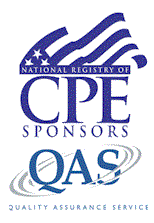Celebrating 25 years serving our friends and customers!
Auditing - Successful Audit PlanningCode: 24-AUDPLAN
Price: $99.00
Add to Cart
Add to Cart
Course Details
216 pages
Course description and objectives:
Every business has both current and long-term liabilities that must be tracked and recorded. Accounting for Current and Long-Term Liabilities is a course that discusses important characteristics of liabilities and how liabilities are classified and The auditor uses four phases to meet the overall objective of the audit, which is to express an opinion on the fairness with which the financial statements present fairly. Every audit requires planning, which occurs during the first of the four audit phases. Audit planning is a course that will review the audit planning process. This course will discuss the important of evaluating materiality and risk, which will impact the auditor's planned audit evidence. This course will describe how to develop a preliminary judgment about materiality and consider the most appropriate risks for each engagement. This course will review the eight steps involved in creating the audit plan.
Learning Objectives
At the end of this course, students will be able to:
- Identify the purpose of internal controls.
- Recognize the internal control framework used by most companies based in the United States.
- Identify the interrelated components for an effective internal control system.
- Recognize the purpose of identifying audit risk.
- Recognize the difference between control deficiency, significant deficiency and material weakness.
- Identify why materiality is important for an audit of financial statements.
- Make a preliminary judgment about what amounts to consider material.
- Identify the audit risk model and its components.
- Recognize the impact of engagement risk on acceptable audit risk.
- Recognize the relationship of risks to audit evidence.
- Identify the three types of fraud.
- Identify the SAS that provides guidance to auditors in assessing the risk of fraud
- Recognize the three elements identified by the AICPA to prevent, deter, and detect fraud.
- Recognize who is responsible for identifying and measuring fraud risks and taking steps to mitigate identified risks.
- Identify the procedures to address the risk of management overriding internal controls that are otherwise operating effectively.
- Recognize the characteristics of different types of fraud.
CPE Credit: 10
Level: Intermediate
Instructional Method: Self-Study
NASBA Field of Study: Auditing
Program Prerequisites: None
Advanced Preparation: None

$99.00
Tax Cuts and Jobs Act-Complete Review
great course and content
Patrick DiSalvo
06/14/2021
Verified Buyer
DiSalvo & Associates PLLC
1 of 1 customers found this helpful.
Was this helpful?
TCJA
This is an excellent course. It's long, but very well organized.
Glenn Koszka
12/22/2020
Verified Buyer
Glenn T. Koszka, CPA
2 of 2 customers found this helpful.
Was this helpful?


